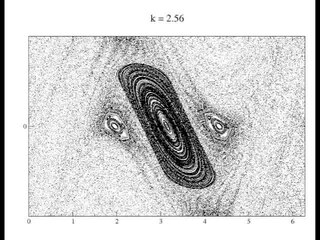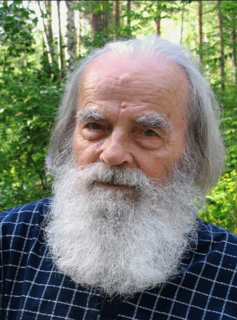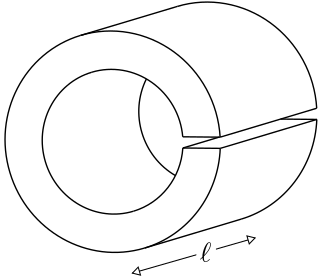
Magnetic circular dichroism (MCD) is the differential absorption of left and right circularly polarized light, induced in a sample by a strong magnetic field oriented parallel to the direction of light propagation. MCD measurements can detect transitions which are too weak to be seen in conventional optical absorption spectra, and it can be used to distinguish between overlapping transitions. Paramagnetic systems are common analytes, as their near-degenerate magnetic sublevels provide strong MCD intensity that varies with both field strength and sample temperature. The MCD signal also provides insight into the symmetry of the electronic levels of the studied systems, such as metal ion sites.

In quantum mechanics, a two-state system is a quantum system that can exist in any quantum superposition of two independent quantum states. The Hilbert space describing such a system is two-dimensional. Therefore, a complete basis spanning the space will consist of two independent states. Any two-state system can also be seen as a qubit.

Magnetic force microscopy (MFM) is a variety of atomic force microscopy, in which a sharp magnetized tip scans a magnetic sample; the tip-sample magnetic interactions are detected and used to reconstruct the magnetic structure of the sample surface. Many kinds of magnetic interactions are measured by MFM, including magnetic dipole–dipole interaction. MFM scanning often uses non-contact AFM (NC-AFM) mode.

The Duffing equation, named after Georg Duffing (1861–1944), is a non-linear second-order differential equation used to model certain damped and driven oscillators. The equation is given by

In classical mechanics, anharmonicity is the deviation of a system from being a harmonic oscillator. An oscillator that is not oscillating in harmonic motion is known as an anharmonic oscillator where the system can be approximated to a harmonic oscillator and the anharmonicity can be calculated using perturbation theory. If the anharmonicity is large, then other numerical techniques have to be used. In reality all oscillating systems are anharmonic, but most approximate the harmonic oscillator the smaller the amplitude of the oscillation is.

A parametric oscillator is a driven harmonic oscillator in which the oscillations are driven by varying some parameter of the system at some frequency, typically different from the natural frequency of the oscillator. A simple example of a parametric oscillator is a child pumping a playground swing by periodically standing and squatting to increase the size of the swing's oscillations. The child's motions vary the moment of inertia of the swing as a pendulum. The "pump" motions of the child must be at twice the frequency of the swing's oscillations. Examples of parameters that may be varied are the oscillator's resonance frequency and damping .
The Rabi problem concerns the response of an atom to an applied harmonic electric field, with an applied frequency very close to the atom's natural frequency. It provides a simple and generally solvable example of light–atom interactions and is named after Isidor Isaac Rabi.
In mathematics, Smale's axiom A defines a class of dynamical systems which have been extensively studied and whose dynamics is relatively well understood. A prominent example is the Smale horseshoe map. The term "axiom A" originates with Stephen Smale. The importance of such systems is demonstrated by the chaotic hypothesis, which states that, 'for all practical purposes', a many-body thermostatted system is approximated by an Anosov system.
The Rabi frequency is the radian frequency of the Rabi cycle undergone for a given atomic transition in a given light field. This is thus the frequency of fluctuations in the populations of the two atomic levels involved in that atomic transition in that situation. It is proportional to the strength of the coupling between the light and the atomic transition and to the amplitude of the light's electric field. Rabi flopping between the levels of a 2-level system illuminated with light exactly resonant with the transition will occur at the Rabi frequency; when the incident light is detuned from resonance then this occurs at the generalized Rabi frequency. The Rabi frequency is a semiclassical concept as it is based on a quantum atomic transition and a classical light field.

The standard map is an area-preserving chaotic map from a square with side onto itself. It is constructed by a Poincaré's surface of section of the kicked rotator, and is defined by:

Boris Valerianovich Chirikov was a Soviet and Russian physicist. He was the founder of the physical theory of Hamiltonian chaos and made pioneering contributions to the theory of quantum chaos. In 1959, he invented the Chirikov criterion which gives an analytical estimate for the overlap of resonances and provides the conditions for transition from integrability to global chaos in Hamiltonian dynamical systems.

The Bloch–Siegert shift is a phenomenon in quantum physics that becomes important for driven two-level systems when the driving gets strong.
In the fields of nonlinear optics and fluid dynamics, modulational instability or sideband instability is a phenomenon whereby deviations from a periodic waveform are reinforced by nonlinearity, leading to the generation of spectral-sidebands and the eventual breakup of the waveform into a train of pulses.
In mathematics and electronics, Cavity perturbation theory describes methods for derivation of perturbation formulae for performance changes of a cavity resonator.
Ramsey interferometry, also known as Ramsey–Bordé interferometry or the separated oscillating fields method, is a form of particle interferometry that uses the phenomenon of magnetic resonance to measure transition frequencies of particles. It was developed in 1949 by Norman Ramsey, who built upon the ideas of his mentor, Isidor Isaac Rabi, who initially developed a technique for measuring particle transition frequencies. Ramsey's method is used today in atomic clocks and in the S.I. definition of the second. Most precision atomic measurements, such as modern atom interferometers and quantum logic gates, have a Ramsey-type configuration. A modern interferometer using a Ramsey configuration was developed by French physicist Christian Bordé and is known as the Ramsey–Bordé interferometer. Bordé's main idea was to use atomic recoil to create a beam splitter of different geometries for an atom-wave. The Ramsey–Bordé interferometer specifically uses two pairs of counter-propagating interaction waves, and another method named the "photon-echo" uses two co-propagating pairs of interaction waves.
Magnetic resonance is a quantum mechanical resonant effect that can appear when a magnetic dipole is exposed to a static magnetic field and perturbed with another, oscillating electromagnetic field. Due to the static field, the dipole can assume a number of discrete energy eigenstates, depending on the value of its angular momentum quantum number. The oscillating field can then make the dipole transit between its energy states with a certain probability and at a certain rate. The overall transition probability will depend on the field's frequency and the rate will depend on its amplitude. When the frequency of that field leads to the maximum possible transition probability between two states, a magnetic resonance has been achieved. In that case, the energy of the photons composing the oscillating field matches the energy difference between said states. If the dipole is tickled with a field oscillating far from resonance, it is unlikely to transition. That is analogous to other resonant effects, such as with the forced harmonic oscillator. The periodic transition between the different states is called Rabi cycle and the rate at which that happens is called Rabi frequency. The Rabi frequency should not be confused with the field's own frequency. Since many atomic nuclei species can behave as a magnetic dipole, this resonance technique is the basis of nuclear magnetic resonance, including nuclear magnetic resonance imaging and nuclear magnetic resonance spectroscopy.

Cavity optomechanics is a branch of physics which focuses on the interaction between light and mechanical objects on low-energy scales. It is a cross field of optics, quantum optics, solid-state physics and materials science. The motivation for research on cavity optomechanics comes from fundamental effects of quantum theory and gravity, as well as technological applications.
Adiabatic radio frequency (RF) pulses are used in magnetic resonance imaging (MRI) to achieve excitation that is insensitive to spatial inhomogeneities in the excitation field or off-resonances in the sampled object.
Phase reduction is a method used to reduce a multi-dimensional dynamical equation describing a nonlinear limit cycle oscillator into a one-dimensional phase equation. Many phenomena in our world such as chemical reactions, electric circuits, mechanical vibrations, cardiac cells, and spiking neurons are examples of rhythmic phenomena, and can be considered as nonlinear limit cycle oscillators.

A loop-gap resonator (LGR) is an electromagnetic resonator that operates in the radio and microwave frequency ranges. The simplest LGRs are made from a conducting tube with a narrow slit cut along its length. The LGR dimensions are typically much smaller than the free-space wavelength of the electromagnetic fields at the resonant frequency. Therefore, relatively compact LGRs can be designed to operate at frequencies that are too low to be accessed using, for example, cavity resonators. These structures can have very sharp resonances making them useful for electron spin resonance (ESR) experiments, and precision measurements of electromagnetic material properties.















